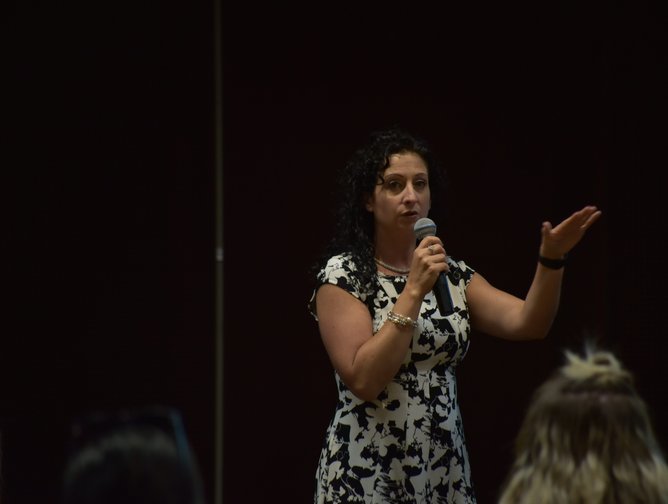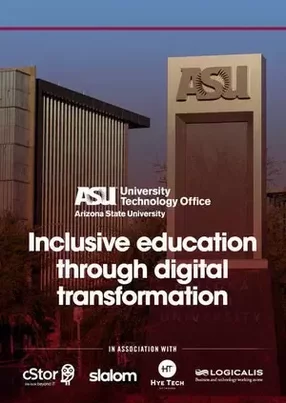Arizona State University (ASU) has enjoyed a remarkable uptick in reputation in recent years, and its success comes down to the efficacy of its digital transformation. “Over the past several years, specifically the last six, the university has grown exponentially in terms of improving both its academic presence and innovation schedule,” says Dr Jess Evans, Chief Operating and Digital Transformation Officer at ASU’s University Technology Office (UTO). “Case in point: for the last four years, US News and World Report has rated ASU as the most innovative university in the country, ahead of giants like Massachusetts Institute of Technology (MIT) and Stanford.” Evans credits this meteoric shift to the vision of ASU President, Michael Crow. “He has set forth a strategy to truly transform the entire university, both in the way we do business and how higher education works,” she says. “The vision looks to change the model of institutions fundamentally grounding themselves in exclusivity. At ASU, we are proud of not who we exclude, but who we include. We are looking to give every student an opportunity.”
This strategy – which has involved the introduction of new course program structures, remote study options and partnerships with companies such as Starbucks and Uber – has led to a surge in the university’s student headcount. “We’re now climbing above 40,000 online students, and this puts the entire ASU student count at above 111,000 in total,” says Evans. This growth would not have been sustainable with the university’s traditional infrastructure, and tackling this challenge is the crux of Evans’s work at the UTO. “We need creative and innovative ways to address this demand, deliver excellent customer service and keep a mindful eye toward fiscal responsibilities.” To meet the computational demands of such a large student body, ASU is in the process of transferring most of its on-premise infrastructure to cloud solutions. Evans stresses that this is not a simple ‘lift and shift’, noting that the transition has involved the establishment of a DevSecOps methodology, the use of automation-based tech and a people-oriented focus on reskilling existing staff to make the most of the changes. “We have 300 code-based robots transitioning many of our on-prem resources to the cloud without the need for human intervention, and this frees up our staff to start developing new skills.”
Realigning existing staff with new processes is vital to the wider change management strategy, which Evans earmarks as the keystone of the digital transformation. To that end, ASU Chief Culture Officer, Christine Whitney Sanchez, has collaborated with her throughout their transformative efforts. “She and I have partnered to align our strategic goals and objectives, as well as give the organization a vehicle of empowerment,” says Evans. “Bringing our teams together and having them vested in this transition has been as crucial as some of the technical projects we have delivered, if not more so. Through this cultural transformation, we’ve given multiple teams a voice and empowered them to assist with shaping how they work in a truly agile way. We are iterating, we are learning, and we’re doing it together as a group.” Evans says that the effectiveness of ASU’s digital transformation hinges on the strength of its cultural transformation. Any organization seeking to leapfrog a potent change management strategy must address culture or they will only be enabling short-term success. “Sustainable success comes from working on culture, being credible, and leading in an intentional way. We, the UTO executive leadership team, have made great strides in transforming how we operate, and we’re seeing the results permeate throughout the organization.”
Part of the challenge of effective change management at ASU is reflected in a significant technological opportunity: the vastness of the University’s network. In Arizona, ASU’s core footprint is comprised of four major campuses in the greater Phoenix metro area with an expanding campus in Lake Havasu. In addition to this state-based presence, the organization has a range of small satellite academic areas in Washington DC and California, with a another one due in Hawaii soon. This geographic range, coupled with the demand of an ever-expanding student body and the Internet of Things (IoT) devices comprising a growing smart campus infrastructure, has necessitated the advent of ASU’s NextGen Network. Evans inherited an environment whereby network operations were wholly outsourced to a service provider, and bringing that network into direct control offers myriad benefits. “With the goal of having a hybrid model, ASU will have traditional engineers back on the table to lead architecture and design while collaborating with multiple partners to hone our strategies and ensure our larger portfolio of services is enabled. The unique difference of this collaborative structure contractually requires all parties (external and internal to ASU) to hold each other accountable for SLAs and performance metrics.” By bringing the network under the UTO’s influence, tailoring the functions of the network to manage the workload of the university’s smart campus ambitions becomes significantly easier.
The vision of the NextGen Network doesn’t end there, however. “If your network isn’t designed to handle that influx of traffic, you’ll come to a crashing halt, so we are going to design a software-defined network (SDN),” says Evans. “We’re holding a proof of concept ‘bake off’ between vendors to see who has the best SDN solution in the market, and we intend to elect a provider and put the first instance into production by January 2020,” she explains. In the long-term, Evans says that the aim is to achieve something that no other known higher education establishment in the world has yet managed: a fully-fledged, serverless architecture. “Our goal is to have a predominantly infrastructure free footprint in the long term, and that is truly radical: we will leverage our code and developer power to provision hardware both in the cloud and within strategic local physical locations. These goals are reliant on a well-designed and robust network that will handle the influx of large data traversing over the network. We plan to hire engineers to help us develop and build these NextGen technologies in partnership with whichever SDN partner we select. Through this, we will become the first full-fledged higher education SDN on the planet. This transformation is truly cutting-edge.”
The breadth of ASU’s smart campus achievements and ambitions will grow exponentially with the establishment of the robust NextGen Network, but thus far they are well encapsulated in the organization’s smart stadium. Anyone attending games at the stadium must have ASU’s mobile app, powered through a partnership with Ticketmaster, for ticketing purposes. This monumental relationship saw Ticketmaster open its API to ASU, revolutionizing the ticketing operations at the stadium and entirely removing paper tickets from the process. More widely, the app has been integrated with Canvas, ASU’s learning management system, to offer students quick access to their schedules, campus maps, information regarding financial aid and more. Under the leadership of Chris Richardson, Deputy CIO for Development, Mobility and Smart Cities, the app has been a resounding success: it has thus far enjoyed over 80,000 downloads from students, with an expanding focus to include faculty and staff features in the coming year. Not only that, but preliminary IoT solutions have been prototyped in select suites at the stadium to monitor trash volume, stadium footfall and the frequency of guests sitting and standing.
Looking forward, this breed of intelligence and data gathering will be expanded in earnest across ASU’s locations. “The development team will help us with more IoT capabilities,” says Evans. “They have built a facial recognition program that will, in the long term, be combined with IoT programs to improve safety and security on campus.” A greater degree of smart lighting, vehicle traffic and parking monitoring and more are also in the works, and each piece of tech is set to upgrade the campus experience in a meaningful way. Ultimately, this quality applies to ASU’s digital transformation across the board. “Digital transformation is not just transforming your digital services,” concludes Evans. “You need to transform your culture, your people and your back office processes. You need to be creative, and those changes must be made as a group – a holistic end-to-end approach – in order to be sustainable.”




- Top 100 Women 2024: Tanja Rueckert, Bosch - No. 6Digital Transformation
- Coforge: Arming Financial Firms with the Tools to InnovateDigital Transformation
- Coforge: Arming Financial Firms with the Tools to InnovateDigital Transformation
- MWC24: Harnessing AI to Modernise Telcos with Tech MahindraDigital Transformation

